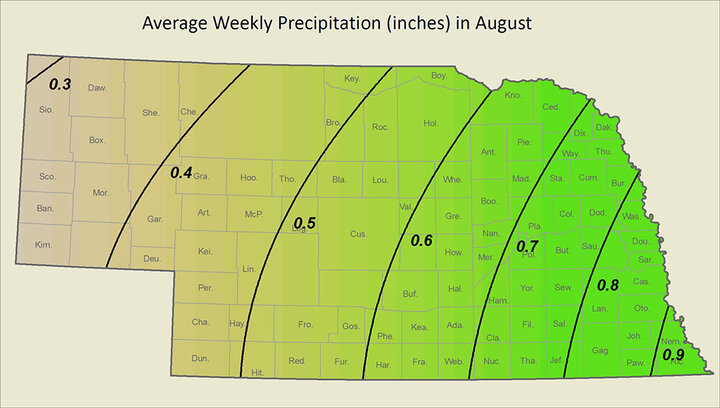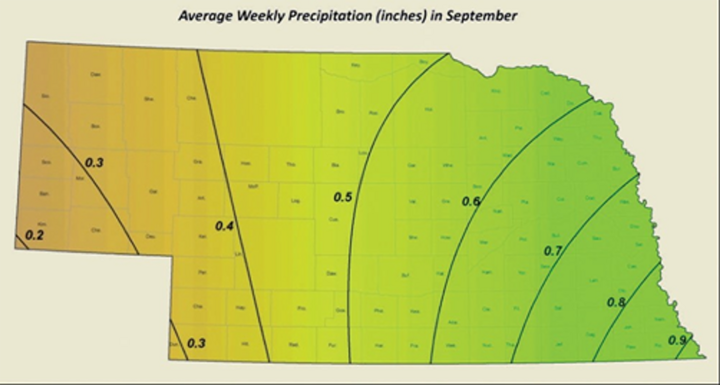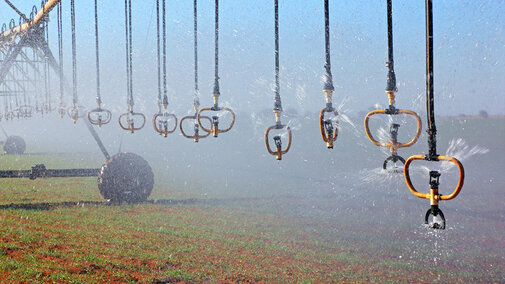With pumping costs ranging from $6-15/acre-inch this year, any opportunity to save money by cutting back irrigation as early as possible sounds like a good strategy. Correctly timing the last few irrigations of the season offers an excellent opportunity to save some water and money.
Factors such as the amount of water a soil can hold, the amount of water a crop will use until it reaches maturity, and the maximum allowable soil water depletion should be considered when deciding the last few irrigations of the season. In addition to water and dollar savings, another benefit of leaving the fields as dry as possible without lowering yields is the potential to reduce issues with nutrient leaching and increase the amount of precipitation stored during the offseason.
The amount of water used by the plants during the tail end of the growing season changes from crop to crop. With different crops, it is important to know how weather conditions affect crop water use. For instance, weather conditions will affect the water use of the beans because they tend to mature based on daylength, as opposed to corn and sorghum that mature based on growing degree days. Thus, for corn and sorghum, hotter conditions will result in more water use per day but will also mature the crop sooner. On the other hand, beans may use more water during hotter weather conditions but won’t mature quicker, resulting in greater total water use.
The data given in Table 1 shows how much water corn and soybean will need until they reach maturity based on each growth stage. This is the baseline information needed when it comes to deciding the last irrigation of the season. Figures for grain sorghum and dry beans can be found in NebGuide G1871, "Predicting the Last Irrigation of the Season".
We should always keep adequate soil moisture levels to maximize yield on irrigated fields if we have the water. During peak water use, UNL recommends maintaining soil water storage levels above 50% of plant available water in the top three feet of soil. As plants approach the end of the cropping season, the days are getting shorter and cooler and their leaves begin to lose the ability to transpire water, which opens an opportunity to let the soil dry to a lower water content without affecting yield. The UNL recommendation is to lower the soil water content to 40% of plant available water to a four-foot depth after the dough stage in corn and R4-end of pod elongation in soybean.
Another factor besides knowing how much water the crops will use between now and maturity is determining the amount of water stored in the soil. A fine sand soil, for example, holds about one inch per foot of soil or four inches on the top four feet of soil. A silt loam soil, on the other hand, holds two inches per foot of soil or eight inches on the top four feet of soil. Assuming both soils are at field capacity, the maximum amount of water that can be used is 2.4 inches (60% of four inches) for the fine sand soil and 4.8 inches (60% of eight inches) for the silt loam soil.
The last piece of information needed is the expected rainfall amounts between today and the date the crop matures. While many parts of the state are very dry this year, one should still keep in mind the long-term average rainfall as shown in Figures 1 and 2.
| Stage of Growth | Approximate Days to Maturity | Water Use to Maturity |
|---|---|---|
| Corn | ||
| R4 - Dough | 34 | 7.5 |
| R4.78 - Beginning dent | 24 | 5.0 |
| R5 - 1/4 milk line | 19 | 3.75 |
| R5 - 1/2 milk line | 13 | 2.25 |
| R5 - 3/4 milk line | 7 | 1.0 |
| R6 - Physiological maturity | 0 | 0 |
| Soybean | ||
| R4 - End of pod elongation | 37 | 9.0 |
| R5 - Beginning seed enlargement | 29 | 6.5 |
| R6 - End of seed enlargement | 18 | 3.5 |
| R6.5 - Leaves begin to yellow | 10 | 1.9 |
| R7 - Beginning maturity | 0 | 0 |


Example Calculations of Late Season Crop Water Need
1. Determine the amount of water needed by the plants based on growth stage as shown in Table 1.
| Days until maturity | Water use to maturity (in) |
|---|---|
| 24 | 5.0 |
| Days until maturity | Water use to maturity (in) |
|---|---|
| 18 | 3.5 |
2. Determine the date plants will reach maturity.
| Today’s date + Days until maturity | Date at maturity |
|---|---|
| 08/26 + 24 | 09/19 |
| Today’s date + Days until maturity | Date at maturity |
|---|---|
| 08/26 + 18 | 09/13 |
3. Determine the amount of expected rainfall.
| Location | Platte County |
|---|---|
| Weekly rainfall in August (in) | 0.7 |
| Average daily rainfall in August (in) | 0.7/7 = 0.1 |
| Number of days in August | 6 |
| Rainfall in August (in) | 6*0.1 = 0.6 |
| Weekly rainfall in September (in) | 0.6 |
| Average daily rainfall in September (in) | 0.6/7 = 0.09 |
| Number of days in September (in) | 19 |
| Rainfall in September (in) | 19*0.09 = 1.71 |
| Rainfall to maturity (in) | 0.6+1.71 = 2.31 |
| Location | Hitchcock County |
|---|---|
| Weekly rainfall in August (in) | 0.5 |
| Average daily rainfall in August (in) | 00.5/7 = 0.071 |
| Number of days in August | 6 |
| Rainfall in August (in) | 6*0.071 = 0.43 |
| Weekly rainfall in September (in) | 0.4 |
| Average daily rainfall in September (in) | 0.4/7 = 0.057 |
| Number of days in September (in) | 13 |
| Rainfall in September (in) | 13*0.057 = 0.74 |
| Rainfall to maturity (in) | 0.43+0.74 = 1.17 |
4. Calculate the amount of required irrigation to maturity
| Location | Platte County |
|---|---|
| Soil type | Silty Clay |
| Holding capacity at the top 4 feet of soil (in) | 6.4 |
| Maximum allowed soil water depletion based on 60% (in) | 0.6*6.4 = 3.84 |
| Crop water use to maturity (in) | 5.0 |
| Total rainfall to maturity (in) | 2.31 |
| Final soil water available (in) | 3.84 – 5.0 + 2.31 = 1.15 |
| Location | Hitchcock County |
|---|---|
| Soil type | Silt Loam |
| Holding capacity at the top 4 feet of soil (in) | 8.0 |
| Maximum allowed soil water depletion based on 60% (in) | 0.6*8 = 4.8 |
| Crop water use to maturity (in) | 3.5 |
| Total rainfall to maturity (in) | 1.17 |
| Final water requirement (in) | 4.8 – 3.5 + 1.17 = 2.47 |
These examples predicted that there is enough water available in both cases. However, these numbers assume you have a soil at full soil water storage and we will get average rainfall amounts until crop maturity. Keep in mind that if the soil water level is more than 1.15 inches below full capacity at the Platte County or 2.47 inches at the Hitchcock County, and average rainfall is not received, additional irrigation will be required.
The main objective with these calculations is to approach the end of the growing season using the stored soil water without affecting crop yields, while also creating room to store the offseason precipitation by lowering the soil water to 40% plant available water. These calculations will be improved if refigured weekly with updated irrigation and rainfall data.
For more information on this topic, see NebGuide G1871, “Predicting the Last Irrigation of the Season”.

